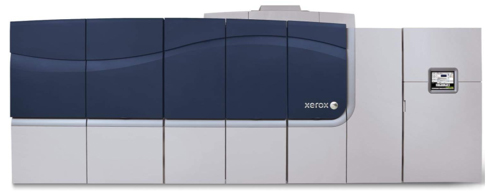Waterless High-Speed Inkjet, No Special Paper Requirements
Today at Hunkeler Innovationdays 2011 in Lucerne, Switzerland, Xerox made its long-awaited production inkjet announcement. The printer, which is yet unnamed, uses a waterless inkjet technology and is able to print on untreated, uncoated papers, as well as a subset of coated papers. Xerox claims that the result of its innovative ink and print head technology is a system that reduces manufacturing costs of print through savings in process cycle time, labor, waste, inventory and warehousing.

Specifications
The Xerox Production Inkjet System is a 4-color CMYK system with speeds up to 500 feet per minute (152 meters per minute). It will be available in both single engine (simplex) and twin engine (duplex) systems. The system being shown at Hunkeler Innovationdays is simplex, but the company is providing samples that have been produced on a duplex system.
Its web width of 20.5” (52cm) could be a disadvantage in some markets, such as books, where other inkjet manufacturers such as Kodak (24.5”), Oce (30”) and HP (30”) offer greater widths. However, Xerox indicates that its market research reflects that customers are largely satisfied with the 20.5” web width as it is compatible with their existing feeding and finishing solutions. The current configuration consists of seven long-life piezo print heads stitched together, and Xerox touts one of the advantages of scalable print heads as the ability to go wider when a decision is made that doing so is advantageous. Two screws and three clips allow for easy changing of print heads should that be required.
The system uses phase change inks that are delivered in a granular form and melted onto the paper. This is what allows the system to print vivid image quality on on normal, low-cost printing papers, including lightweight papers (50 to 160 gsm), without show-through. The ink is fired onto the substrate, and hardens immediately. Intelligent bar scan technology also used in the iGen4 has been applied to the system, with images being read at a pixel level during production. This means that if there is a missing jet, it will be detected in a closed-loop fashion, causing adjacent nozzles to fire eliminating any effect of the missing jet on print quality, in line and in real time.
In terms of coated stocks, Chief Engineer Wayne Buchar explains that the ink requires tooth in the paper surface to be able to grab onto the fibers. On highly coated stocks, there are less fibers to grab onto, although Xerox has had success in printing on some coated papers with these resin-based inks. In addition, the printing process has been INGEDE certified as “Good de-inkable.” He also explained that the printing process uses a combination of temperature, time and pressure to reduce the ink thickness on the paper to the single-digit micron level. Xerox has extensively tested printed output with high-speed inserting equipment and found adequate abrasion resistance and no need to clean the equipment as a result of ink residue.
When asked about the ability to add MICR (especially important in transaction printing) and/or a fifth color, Xerox indicates that the company is already working with specific customers to determine the timeframe against which MICR will be brought to market. Decisions have yet to be made relative to prioritization of a fifth color option.
RIP/Workflow
Front-ended by a Xerox FreeFlow Print Server which Xerox states is its most powerful server yet, the scalable RIP supports native data streams including IPDS, PDF (including PDF/VT), PostScript and Xerox' proprietary VIPP data stream. Xerox reports that there are more than 40,000 Xerox FreeFlow Print Servers installed worldwide. The front-end workflow will also support multi-vendor environments that include products from InfoPrint Solutions, HP, Océ and others.
At the show, Xerox leveraged its partnership with GMC Software Technology, demonstrating the integration between GMC's PrintNet software and the Xerox FreeFlow Print Server that allows this multivendor data stream support.
Other partners at launch include Hunkeler, Solimar Systems, Kern, Lasermax/Roll Systems, and Böwe Bell+Howell.
Target markets for the system include transactional printing; TransPromo; direct mail; books, manuals and catalogs; educational & children's books and newsprint.
The product is supported with Xerox' extensive suite of business development options, including ProfitAccelerator and ProfitQuick financial modeling, to help prospective buyers reach a buying decision and more rapidly bring a new installation to profitability.
Pricing and Availability
While full availability of the system is planned for 2012, ordertaking will begin immediately for select customer with installs in the second half of 2011. No pricing information has yet been made publicly available.
Further announcements relative to this product can be expected in the September 2011 timeframe, presumably at Graph Expo. Xerox indicates it has performed extensive competitive analysis and the system will be cost competitive with all inkjet vendors in the market, being additionally advantaged by its ability to print on plain papers.
Analysis
NOTE: This article was based on a briefing delivered by Xerox under nondisclosure prior to the official announcement. WhatTheyThink will be posting video and other information from the show as it becomes available.
While Xerox has come to the inkjet party later than its competitors, the technology has some interesting advantages, including the ability to print on low-cost papers, which might speed the transition of some applications from offset to digital as well as eliminate the need to use preprinted papers for many applications. MICR is clearly an element that must be added to the mix quickly, especially to address the transactional/TransPromo opportunity.
Watch WhatTheyThink for further updates as more details become available.














